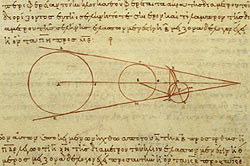
Sun-Earth Day Presents: Eclipse, In a Different Light
Although no renderings of solar eclipses are available, ancient astronomers certainly knew about them and worked hard to predict when the next one would arrive.
TECHNOLOGY THROUGH TIME ISSUE #33: ANCIENT GREECE

By 450 BC, the Greek civilization was in its ascendancy. The historian Herodotus (ca 460 BC) mentions that Thales was able to predict the year when a total solar eclipse would occur. Details of how this prediction was made do not survive. The eclipse occurred in either 610 BC or 585 BC. Apparently the method used worked only once because what is known of Greek scientific history does not suggest that the method was ever reliably used again. Thales is said to have visited Egypt, and from the empirical rules in use there for land surveying, brought back to Greece the ideas of deductive geometry later codified by Euclid. Before 450 BC, Meton realized that a single period of 235 lunar months (19 years) would cause the popular lunar calendar to return to synchrony with the solar, seasonal calendar. At this time, the same lunar phase would be recorded at the same time of the solar calendar year. This period also gives a rough guide to when a lunar eclipse will recur at the same geographic location. Ptolemy (ca 150 AD) represents the epitome of knowledge of Grecian astronomy. Records such as the Almagest show he had a sophisticated scheme for predicting both lunar and solar eclipses. Ptolemy knew, for example, the details of the orbit of the Moon including its nodal points. He also knew that the Sun must be within 20 degrees 41' of the node point, and that up to two solar eclipses could occur within seven months in the same part of the world. Lunar eclipses were especially easy to calculate because of the vast area covered by Earth's shadow on the Moon. Solar eclipses however required much greater knowledge. The shadow of the Moon on Earth is less than 100 kilometers wide, and its track across the daytime hemisphere is the result of many complex factors that cannot be anticipated without a nearly complete understanding of the lunar orbit and speed. [My nasa essay]
This image (above) is from a tenth century Greek copy of a noteworthy work by Aristarchus of Samos written in the second century B.C.E. titled "On the Distances and Sizes of the Sun and Moon," in which he calculates the ratio of the distance between Earth and the Sun to that between Earth and the Moon. (His estimate was more than an order of magnitude too small, but the fault was in his lack of accurate instruments rather than in his correct method of reasoning.) This detail compares the line subtending the arc dividing the light and dark portions of the Moon in a lunar eclipse with the relative diameters of the Moon and the Sun. Aristarchus also found an improved value for the length of the solar year. [http://wps.prenhall.com/esm_chaisson_astronomytoday_5/0,9185,1383966-content,00.html]

In the Odyssey (XX, 356-357 and 390), Homer adds that the Sun vanished out of heaven and an evil gloom covered all things about the hour of the midday meal, during the celebration of the new moon. A total eclipse of the Sun was visible from the Greek island of Ithaca on April 16, 1178 BC. This would be six years after the end of the ((Greek mythology) a great war fought between Greece and Troy; the Greeks sailed to Troy to recover Helen of Troy, the beautiful wife of Menelaus who had been abducted by Paris; after ten years the Greeks (via the Trojan Horse) achieved final victory and b) Trojan War, as traditionally dated (1184 BC), though within the Odyssey narrative it's supposed to be ten years after it. [Absolute Astronomy]
RELATED SITES
Technology Through Time
ISSUES
- #46: The Magnetic Sun
- #45: Coronagraph
- #44: Einstein
- #43: Coronium
- #42: The Sun - In a Different Light
- #41: Gallery of Drawings
- #40: First Sun Photo
- #39: Solar Spectroscopy
- #38: George Ellery Hale
- #37: Coronal Mass Ejections
- #36: First Corona Descriptions
- #35: First Sunspot Drawing
- #34: Ptolemy
- #33: Ancient Greece
- #32: Ancient Babylon
- #31: Galileo Galilei
Eclipse Fact
A total solar eclipse is not noticable until the Sun is more than 90 percent covered by the Moon. At 99 percent coverage, daytime lighting resembles local twilight.


